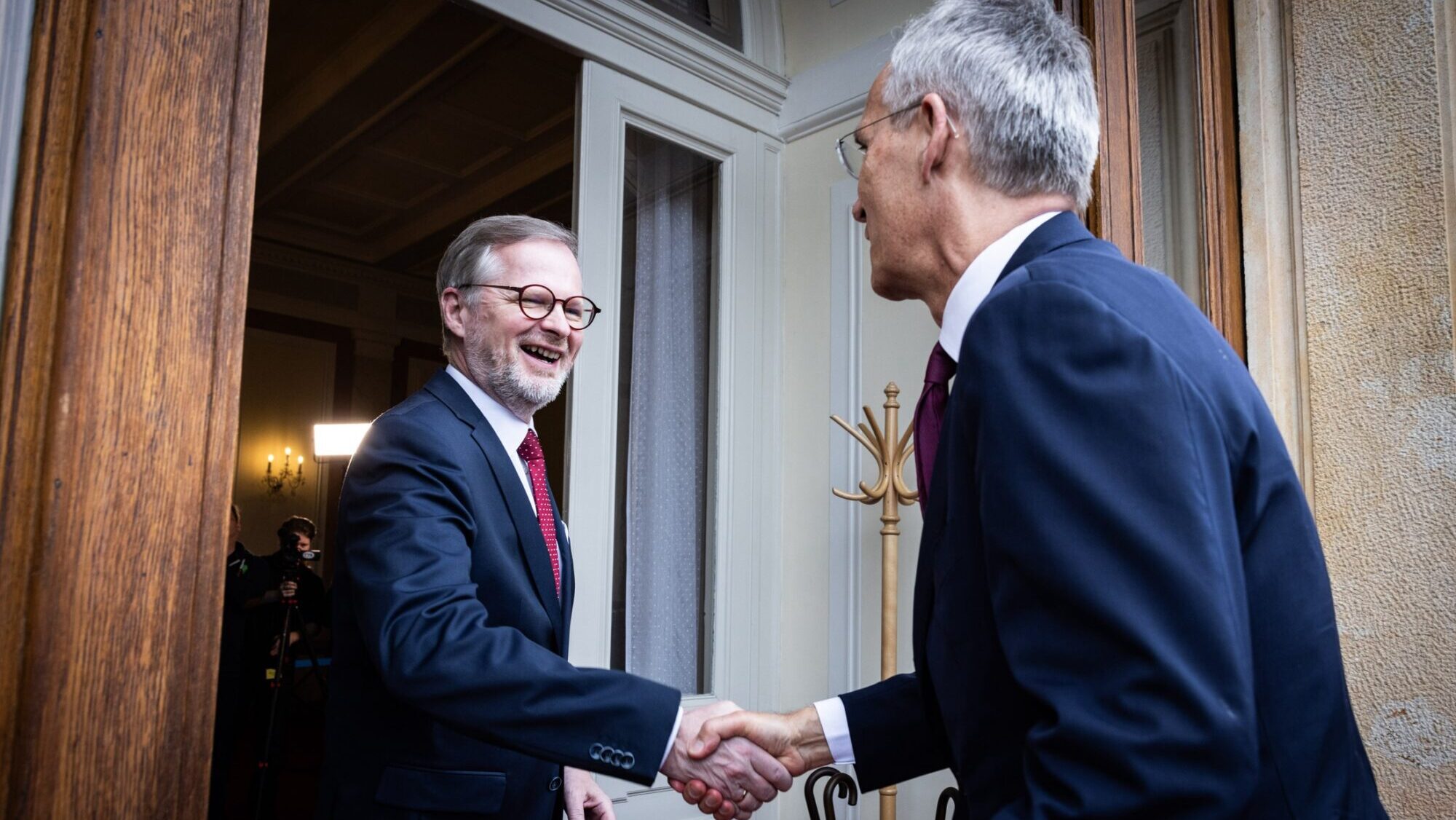
NATO Secretary General Jens Stoltenberg (left), and Czech Prime Minister Petr Fiala in Prague.
Photo: NATO
NATO foreign ministers are meeting in Prague on Thursday and Friday (May 30-31), to prepare for July’s summit in Washington and to discuss immediate questions related to helping Ukraine and strengthening Western security. Kyiv hopes that, by the end of the second day, it will have permission to use long-range Western weapons against targets inside Russia, which is no longer a red line for most influential NATO members—except the U.S.
The Prague meeting is an “important moment to continue preparing for the upcoming summit in Washington,” NATO’s outgoing Secretary General Jens Stoltenberg said on Thursday during the opening press conference.
Stoltenberg—who has long been asking countries to give up their restrictive policies that “tie … one hand of the Ukrainians on their back”—promised that the Washington summit will give the alliance a “greater role” in the war, including arming, training, and financing Ukraine.
Standing alongside Stoltenberg, Czech Prime Minister Petr Fiala said he was happy to host the event because there is much to discuss, as it was important to become “active” in helping Ukraine’s war effort.
The only thing the two leaders did not mention during their first press conference was the one thing Kyiv wants them to address the most: the free use of long-range weapons in Russia.
The question of whether to allow Ukraine to use long-range Western weapons to strike targets deep inside Russia has long been the subject of political discussion in NATO member states. For Kyiv, such permission would be “a matter of survival,” as MP Yehor Cherniev, Ukraine’s top associate diplomat in the NATO Parliamentary Assembly, put it. However, Western lawmakers have been hesitant due to the frequent threats from the Kremlin regarding such a scenario.
Moscow has been particularly angered by the fact that certain countries had gradually decided to provide Ukraine with long-range cruise missiles (such as the British-French Storm Shadow or the German Taurus missile systems, as well as the U.S.-made ATACMS). Such weapons systems can carry out precision strikes on critical targets hundreds of kilometers behind enemy lines, including a potential attack on the Kerch Bridge, connecting occupied Crimea to Russia proper.
Kyiv’s pleas for permission to use these weapons as it pleases—including for preemptive strikes—increased after Russia began a new offensive in the north and relentlessly bombed the city of Kharkiv. “It is important that our partners have enough determination for preemptive protection against Russian terrorists, just as they would strike at any other terrorists — destroying them before they start taking lives,” President Zelensky argued in a statement last week.
While the greater decisions—such as a more direct invitation to the alliance—are reserved for July’s NATO summit in Washington, Kyiv expects the ongoing ministerial meeting in Prague to at least provide an immediate solution to this problem.
Most NATO member states in Europe have already signaled that they regard the Russian threats as a bluff and have no problem with Ukraine striking Russian targets with Western weapons. These include the UK, Sweden, Poland, Finland, the Netherlands, Czechia, and the Baltic countries.
Germany and France also joined them ahead of this week’s meeting but with certain pre-conditions. French President Emmanuel Macron gave permission to use Storm Shadow missiles to “neutralize” Russian targets from where enemy missiles are fired, but not other civilian or military targets. German Chancellor Olaf Scholz was intentionally more vague, saying that Kyiv may use the donated weapons however it pleases, as long as it stays “within the framework of international law.”
This leaves the United States as the only major NATO member that is still on the fence. “There’s no change to our policy at this point,” National Security Council spokesman John Kirby stated on Tuesday, following the joint Franco-German announcement. “We don’t encourage or enable the use of U.S. weapons to strike inside Russia.”
Nonetheless, most allies believe it is just a matter of time, as has been the case of all the other “red lines” put up by Russia. Last week, for instance, Belgium became the first country to confirm it had donated much-needed F-16 fighters to Ukraine, with the condition that they will not be flown over Russia. Initially, it was the same with Western long-distance artillery and Germany’s Leopard tanks.
“We saw that with strikes on Crimea, and with the provision of HIMARS and other Western weapons to Ukraine, there used to be red lines, full of threats, not anymore,” Cherniev said.
